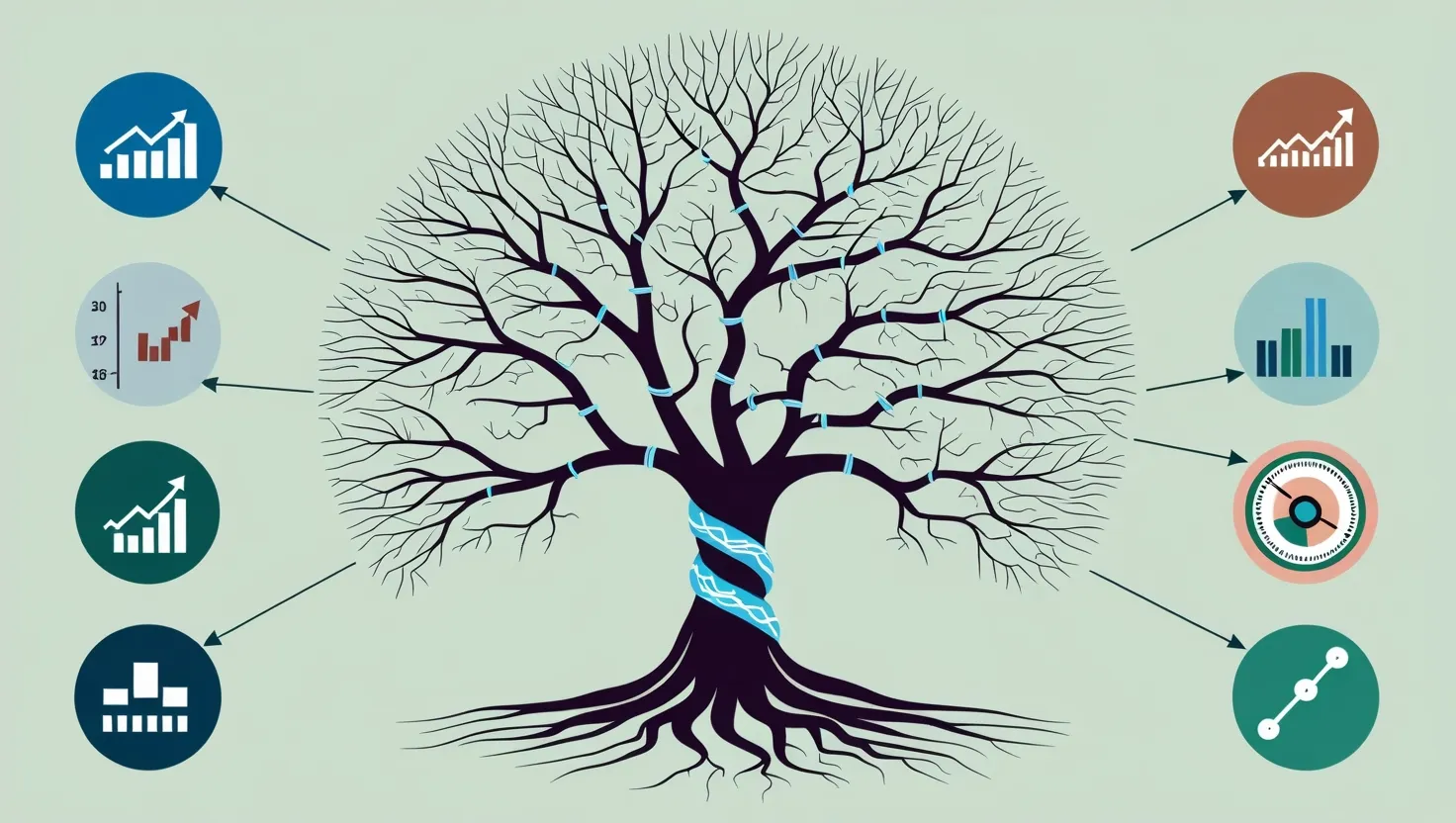Imagine a world where your investment strategy is as dynamic and adaptable as your brain’s neural pathways. This isn’t about sticking to traditional asset allocation or blindly following market trends. It’s about creating a living, breathing portfolio that evolves with the market, much like how our brains rewire themselves in response to new experiences.
The Concept of Neuroplasticity
Neuroplasticity, the brain’s ability to change and adapt, is a powerful concept that can be applied to various aspects of life, including finance. Just as our brains form new connections and strengthen existing ones through learning and practice, an investment strategy can be trained to adapt to diverse market conditions. This approach turns each market fluctuation into an opportunity for growth, rather than a source of stress.
Diversification as a Form of Neuroplasticity
When you diversify your portfolio, you’re essentially exposing your investment strategy to different market conditions. This is similar to how neuroplasticity works in the brain, where new experiences and challenges help form new neural pathways. By investing in a variety of assets, such as stocks, bonds, real estate, and commodities, you’re creating a resilient portfolio that can navigate different economic environments.
For instance, consider an investor who has a mix of tech stocks, healthcare stocks, and real estate investments. When the tech sector experiences a downturn, the healthcare and real estate components of the portfolio can help stabilize it. This diversification is akin to the brain’s ability to compensate for damaged areas by rerouting functions through other pathways.
Learning from Market Feedback
Just as the brain learns from feedback and adjusts its responses accordingly, an adaptive investment strategy learns from market feedback. This involves regularly reviewing your portfolio’s performance, seeking feedback from financial advisors or mentors, and making adjustments based on what you’ve learned.
For example, if you notice that your portfolio is heavily weighted towards a particular sector that’s experiencing volatility, you might decide to rebalance it by investing in more stable sectors. This process of continuous learning and adaptation is crucial for developing a resilient and intuitive investment style.
The Role of AI and Data Analytics
Artificial intelligence (AI) and data analytics play a significant role in this neuroplastic investing approach. AI can analyze vast amounts of market data to identify subtle patterns and trends that might elude human analysts. This is similar to how AI is used in neuroscience to analyze brain data and identify clinically meaningful patterns.
By leveraging AI and data analytics, you can make more informed investment decisions and adapt your strategy more quickly to changing market conditions. For instance, AI can help you identify emerging trends in sectors like renewable energy or biotechnology, allowing you to invest early and capitalize on growth opportunities.
Visualization and Mental Rehearsal
Visualization and mental rehearsal are techniques used in neuroplasticity to strengthen neural pathways associated with specific skills and behaviors. These techniques can also be applied to investment strategies. Imagine yourself navigating different market scenarios and making successful investment decisions. This mental practice can enhance your real-world performance by preparing you for various market conditions.
For example, you might visualize a scenario where interest rates rise and how you would adjust your portfolio to mitigate the impact. This mental rehearsal can help you make quicker and more confident decisions when faced with actual market fluctuations.
Mindfulness and Stress Management
Chronic stress can negatively impact both brain health and investment decisions. Practicing mindfulness and stress management techniques, such as meditation or deep breathing, can help reduce stress and improve focus. This is crucial for making clear-headed investment decisions, especially during volatile market periods.
Incorporating mindfulness into your daily routine can also help you stay calm and think more critically about your investments. For instance, taking a few minutes each day to meditate can help you approach market challenges with a clearer mind and make more rational decisions.
Healthy Lifestyle Choices
A healthy lifestyle is essential for maintaining brain health and, by extension, for making sound investment decisions. Physical activity, healthy eating, and sufficient sleep are all critical for cognitive function and adaptability.
For example, regular exercise has been shown to improve cognitive functions such as memory and processing speed. A balanced diet rich in nutrients like omega-3 fatty acids, vitamins, and minerals supports brain health. Adequate sleep is also vital for cognitive function and decision-making.
Creating a Supportive Environment
Surrounding yourself with a supportive network of peers and mentors is crucial for continuous learning and adaptation in both personal and financial contexts. This supportive environment encourages growth and development, much like how a collaborative learning environment fosters neuroplasticity.
Engage in discussions with other investors, attend financial workshops, and seek advice from financial advisors. This collaborative approach helps you stay updated on market trends and best practices, allowing you to adapt your investment strategy more effectively.
Celebrating Progress
Acknowledging and celebrating your achievements, no matter how small, is important for reinforcing positive behaviors and motivating continued effort. This applies to both personal development and investment strategies.
For instance, if you successfully navigate a market downturn and come out with minimal losses, celebrate that achievement. Recognizing your progress reinforces the strategies that worked and motivates you to continue adapting and improving your investment approach.
Leveraging Brain Capital Technologies
The concept of brain capital, which includes brain health and brain skills, is becoming increasingly important in various sectors, including finance. Investing in brain capital technologies, such as neuroscience-inspired tools and AI-driven analytics, can enhance your investment strategy.
These technologies can help you make more informed decisions by providing insights into market trends and patterns that might not be immediately apparent. For example, AI-powered tools can analyze market data to predict future trends, allowing you to make proactive investment decisions.
Coordinating Different Fields
Just as brain capital technologies span various fields such as genomics, digital therapeutics, and robotics, an adaptive investment strategy should coordinate different investment areas. This involves aligning your investments across different sectors and asset classes to create a synergistic portfolio.
For instance, if you’re investing in tech stocks, you might also consider investing in healthcare or renewable energy to create a balanced and resilient portfolio. This coordination ensures that your investments are working together to achieve your financial goals, much like how different brain regions work together to achieve cognitive functions.
Long-Term Focus
Investing with a neuroplastic approach requires a long-term focus. Just as neuroplasticity involves gradual changes over time, an adaptive investment strategy involves continuous learning and adaptation over the long term.
Avoid making impulsive decisions based on short-term market fluctuations. Instead, focus on building a portfolio that can withstand various market conditions over the years. This long-term perspective allows you to develop a more resilient and intuitive investment style that adapts to the ever-changing rhythms of the market.
Secular Trends and Demographic Forces
Secular trends, such as aging demographics and medical technology innovation, can create long-term investment opportunities. For example, the increasing age of the global population drives demand for healthcare services and products, making healthcare a promising sector for investment.
Similarly, advancements in medical technology, particularly those driven by AI and neuroscience, offer significant investment opportunities. These trends are akin to the demographic mega forces that shape our brains and behaviors over time, requiring us to adapt and evolve our investment strategies accordingly.
Conclusion
Creating a neuroplastic portfolio is about more than just diversifying your investments or following market trends. It’s about developing an investment strategy that adapts and evolves with the market, much like how our brains adapt to new experiences. By leveraging neuroplasticity principles, AI, and data analytics, you can develop a resilient and intuitive investment style that turns each market fluctuation into an opportunity for growth.
This approach isn’t just about making smart investment decisions; it’s about cultivating a mindset that is open to change, continuous learning, and adaptation. As you navigate the complex and ever-changing landscape of finance, remember that your greatest edge is not just market knowledge, but your strategy’s remarkable ability to adapt and resonate with the market’s rhythms.






